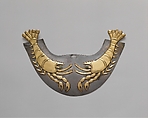Nose Ornament with Shrimp
Not on view
This stunning gold and silver nose ornament featuring two shrimp is an excellent example of the metal-working skills of Moche artists. Centuries before the rise of the Incas, the Moche thrived on Peru’s North Coast between A.D. 200–850, founding impressive regional centers from the Nepeña River Valley in the south to perhaps as far north as the Piura River, near the modern border with Ecuador. They developed extensive irrigation systems that transformed the coastal deserts into rich farmlands and drew upon the abundant maritime resources of the Pacific Ocean’s Humboldt Current. They also built some of the largest adobe structures known in the ancient Americas, many of them richly adorned with polychrome murals and reliefs. Although the Moche likely never formed a single centralized political entity, they shared unifying cultural traits such as religious practices (Donnan 2010).
Moche metallurgists were unrivaled in ancient Peru and this example illustrates their skills. Here they combined two precious metals, gold and silver, to produce an object of great aesthetic quality. The two shrimp, made of gold sheet, were attached to the silver crescent (with squared off points) by small tabs. The contrast between the silver and gold highlights the masterful working of the two facing shrimp. Their bodies, rendered in repoussé, were depicted in considerable detail, from their eyes—here indicated by green stones—to their tail fans, which extend free above the silver crescent. The animal represented is probably a freshwater shrimp, Cryphiops caementarius, which can grow to roughly seven inches in length, and is still found in the rivers of Peru. This species would have been much easier to harvest than maritime shrimp. The symbolic meaning of the shrimp in the context of this nose ornament, however, is unknown. As there was no tradition of writing in South America prior to the arrival of Europeans in the 16th century, it is difficult to determine with any precision why shrimp would have been selected for depiction on such a prominent ornament.
This particular object was said to have come from the burial site of Loma Negra, one of the most northern outposts of Moche culture. The Loma Negra works in metal share similar iconography with ceramics and metalwork from Moche sites farther to the south, such as Ucupe (Bourget 2014). Although the relationship between Loma Negra and the Moche “heartland” remains a subject of debate (see for example Kaulicke 2006), there are many shared traditions, including types of ornaments. Throughout the Moche world, high-status individuals would wear crescent, oval, or square-shaped ornaments of precious metals suspended from the nasal septum, effectively obscuring the mouth of the wearer (Castillo 2017). Such works must have been dazzling, catching the light as the wearer moved, and reminding all who had the privilege of seeing such works of the power of the person who wore it, and his or her ability to marshal rare resources, from the materials themselves to the skills of exceptional artists.
Acknowledgement: Thanks to Dr. Christopher Boyko of the Division of Invertebrate Zoology, American Museum of Natural History, for his help in identifying the shrimp species.
Published References
Eisenberg, Jerome M. "Rain of the Moon: Peruvian Silver at the Metropolitan Museum." Minerva 12, no. 1 (January/February 2001), p. 16, fig. 2.
Holcomb, Melanie, ed. 2018. Jewelry: The Body Transformed. New York: The Metropolitan Museum of Art, pp. 28-29.
Lapiner, Alan C. Pre-Columbian Art of South America. New York: H. N. Abrams, 1976, p. 160, pl. 391.
Newton, Douglas. Masterpieces of Primitive Art: The Nelson A. Rockefeller Collection. New York: Alfred A. Knopf, 1978, p. 208–209.
Newton, Douglas. The Art of Africa, the Pacific Islands, and the Americas. Metropolitan Museum of Art Bulletin, Fall, 1981, p. 2.
Schorsch, Deborah. "Silver-and-Gold Moche Artifacts from Loma Negra, Peru." Metropolitan Museum Journal vol. 33 (1998), p. 113, fig. 7, 8.
King, Heidi, Luis Jaime Castillo Butters, and Paloma Carcedo de Mufarech. Rain of the Moon: Silver in Ancient Peru. New York, New Haven and London: The Metropolitan Museum of Art, 2000, cat. no. 2, pp. 30–31.
King, Heidi. "Regen des Mondes –– Silber in Alt-Peru." Antike Welt: Zeitschrift für Archäologie und Kulturgeschichte vol. 1, no. 32 (January 2001), p. 77, fig. 1.
King, Heidi. "Silber –– Regen des Mondes." Peru-Nachrichten: Perubüro Heidelberg der Erzdiözese Freiburg no. 57 (September 2002), p. 37.
References and Further Reading
Bourget, Steve. Les rois mochica: Divinité et pouvoir dans le Pérou ancient. Paris: Somogy éditions d'art; Geneva: MEG, Musée d'ethnographie de Genève, 2014.
Castillo, Luis Jaime. “Masters of the Universe: Moche Artists and Their Patrons.” In Golden Kingdoms: Luxury Arts in the Ancient Americas, edited by Joanne Pillsbury, Timothy Potts, and Kim N. Richter. Los Angeles: J. Paul Getty Museum, 2017, pp. 24-31.
Disselhoff, Hans-Dietrich. "Metallschmuck aus der Loma Negra, Vicus (Nord-Peru)." Antike Welt vol. 3 (1972), pp. 43–53.
Donnan, Christopher B. “Moche State Religion.” In New Perspectives on Moche Political Organization, edited by Jeffrey Quilter and Luis Jaime Castillo. Washingon D.C.: Dumbarton Oaks Research Library and Collection, 2010, pp. 47-69.
Jones, Julie. "Mochica Works of Art in Metal: A Review." In Pre-Columbian Metallurgy of South America, edited by Elizabeth P. Benson. Washington, DC: Dumbarton Oaks Research Library and Collection, 1979, pp. 53-104.
Jones, Julie, and Heidi King. "Gold of the Americas." The Bulletin of the Metropolitan Museum of Art vol. 59, no. 4 (Spring 2002).
Kaulicke, Peter. “The Vicús-Mochica Relationship.” In Andean Archaeology III, edited by William H. Isbell and Helene H. Silverman. Boston, MA: Springer, 2006, pp. 85-111.
Lechtman, Heather, Antonieta Erling, and Edward J. Barry Jr. "New Perspectives on Moche Metallurgy: Techniques of Gilding Copper at Loma Negra, Northern Peru." American Antiquity vol. 47 (1982), pp. 3-30.
Due to rights restrictions, this image cannot be enlarged, viewed at full screen, or downloaded.

